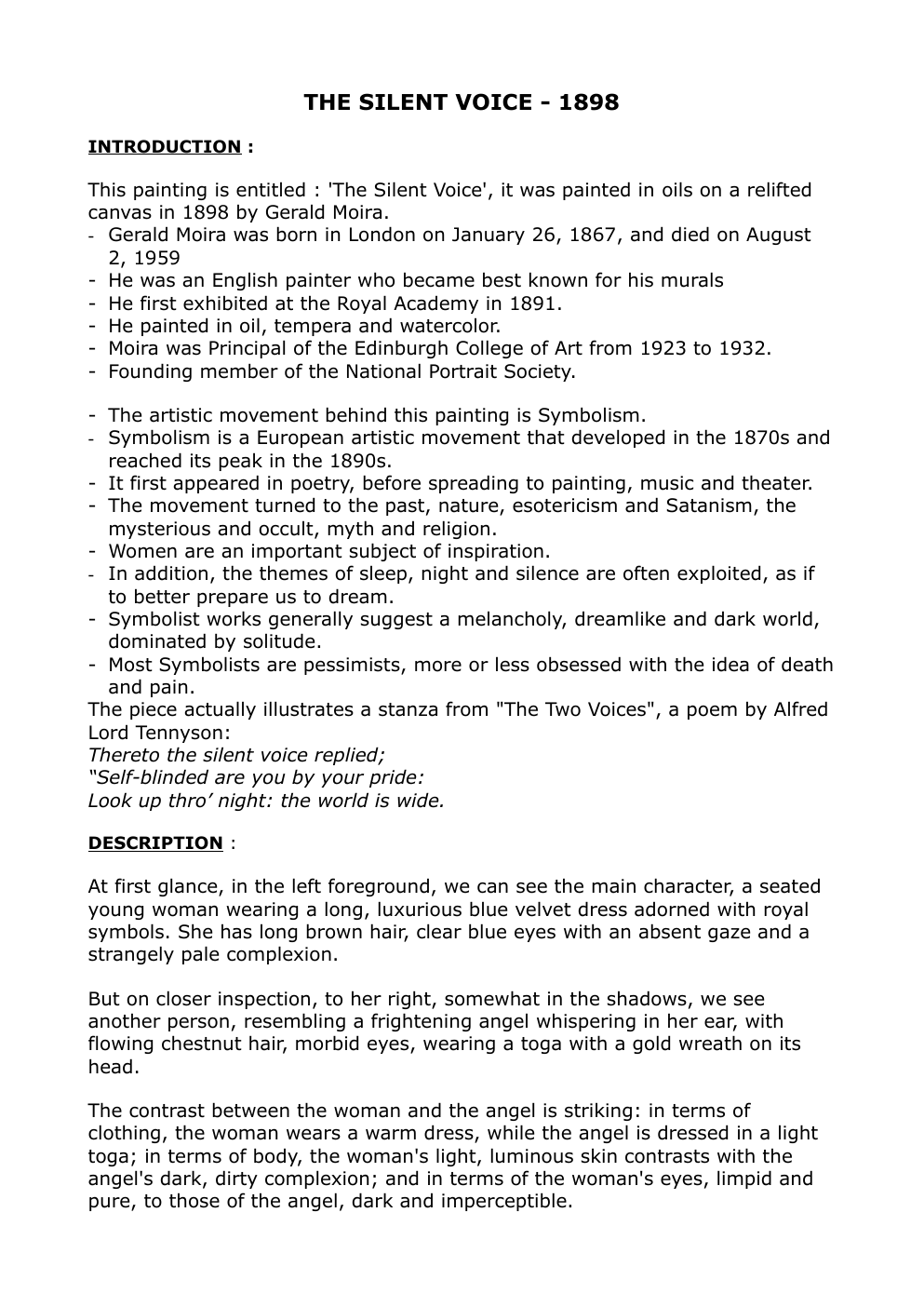THE SILENT VOICE - 1898
Publié le 19/01/2024
Extrait du document
«
THE SILENT VOICE - 1898
INTRODUCTION :
This painting is entitled : 'The Silent Voice', it was painted in oils on a relifted
canvas in 1898 by Gerald Moira.
- Gerald Moira was born in London on January 26, 1867, and died on August
2, 1959
- He was an English painter who became best known for his murals
- He first exhibited at the Royal Academy in 1891.
- He painted in oil, tempera and watercolor.
- Moira was Principal of the Edinburgh College of Art from 1923 to 1932.
- Founding member of the National Portrait Society.
- The artistic movement behind this painting is Symbolism.
- Symbolism is a European artistic movement that developed in the 1870s and
reached its peak in the 1890s.
- It first appeared in poetry, before spreading to painting, music and theater.
- The movement turned to the past, nature, esotericism and Satanism, the
mysterious and occult, myth and religion.
- Women are an important subject of inspiration.
- In addition, the themes of sleep, night and silence are often exploited, as if
to better prepare us to dream.
- Symbolist works generally suggest a melancholy, dreamlike and dark world,
dominated by solitude.
- Most Symbolists are pessimists, more or less obsessed with the idea of death
and pain.
The piece actually illustrates a stanza from "The Two Voices", a poem by Alfred
Lord Tennyson:
Thereto the silent voice replied;
“Self-blinded are you by your pride:
Look up thro’ night: the world is wide.
DESCRIPTION :
At first glance, in the left foreground, we can see the main character, a seated
young woman wearing a long, luxurious blue velvet dress adorned with royal
symbols.
She has long brown hair, clear blue eyes with an absent gaze and a strangely pale complexion. But on closer inspection, to her right, somewhat in the shadows, we see another person, resembling a frightening angel whispering in her ear, with flowing chestnut hair, morbid eyes, wearing a toga with a gold wreath on its head. The contrast between the woman and the angel is striking: in terms of clothing, the woman wears a warm dress, while the angel is dressed in a light toga; in terms of body, the woman's light, luminous skin contrasts with the angel's dark, dirty complexion; and in terms of.... »
↓↓↓ APERÇU DU DOCUMENT ↓↓↓
Liens utiles
- Singin' in the Rain Singin' in the Rain, motion-picture musical about several Hollywood performers adjusting to the transition from silent to sound films during the 1920s.
- Charlie Chaplin Charlie Chaplin (1889-1977), English motion-picture actor, director, producer, and composer, one of the most creative artists in film history, who first achieved worldwide fame through his performances in silent films.
- Arab Music I INTRODUCTION Umm Kulthum Egyptian singer Umm Kulthum was revered throughout Egypt, North Africa, and the Near East for her powerful voice and improvisational skill.
- Radioactivity I INTRODUCTION Marie Curie Working with her husband, Pierre Curie, French physicist Marie Curie discovered the radioactive elements polonium and radium in 1898.
- exposé anglais introduction to the Consumer Society






